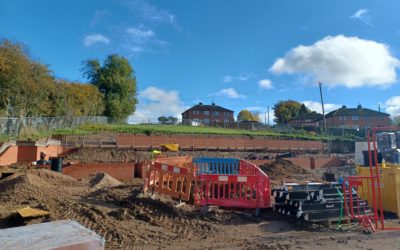Building Rural Communities for the Future
As part of this year’s Rural Housing Week, we take a closer look at a wonderful example of how a rural Shropshire community came together to shape its housing future.
As the third largest town in the county, Oswestry is an important economic hub.
The average open-market house in St Martins, however, is almost 6 times higher than the average salary of its residents, leaving property ownership beyond the reach of many potential local buyers.
In 2013, the council’s Affordable Housing Team identified a rising need for affordable housing in St Martins, as highlighted on the HomePoint Housing Needs Register.
Following in-depth guidance, advice and support from our team, St Martins Parish Council decided to address this need with a Community-Led housing scheme.
Involving the whole community
A Project Board was formed, made up of representatives from the Parish Council, Shropshire Council, the chosen Registered Provider – Wrekin Housing Group, and the wider community.
From approving the design standards to defining the type and tenure of the properties and agreeing a local lettings plan, the Board worked together positively and collaboratively to deliver the required 12 affordable homes for St Martins.
The Board also recognised the importance of involving the wider community to ensure that the whole village felt engaged and invested in the project. Therefore, as well as seeking input from existing parishioners and potential future residents, and keeping them informed through regular meetings, the Board sought to support St Martins’ local economy in every way possible.
CGL Homes – a local contractor and developer – was selected to deliver the homes, while a local timber frame construction specialist was chosen to build frames in their local factory.
Nearby RF Davies Architectural Services served as the scheme’s architect. Local employers naturally play an important role in the parish’s sustainability, and the decision to use local contractors involved community members who may not otherwise have been involved.
Addressing long-term housing need
Construction commenced in 2014 and was completed on schedule in 2015. All 12 homes were quickly filled with people who were local, or who had a strong local connection to St Martins.
However, Bower Farm continued to evolve and make a significant contribution to the community, far beyond its completion date. Once the properties were filled, it became clear that there was a much larger ‘hidden’ need as the community began to see how the properties looked and the positive impact they had on local services and infrastructure.
This hidden need was quickly reflected on the HomePoint Housing Register, and the Board evolved into a steering group to address the issue.
It was decided that Bower Farm should enter Phase 2 and provide a further 25 affordable homes to address need, including Shared Ownership and Affordable Rented properties.
Building for the future
As with Phase 1, the Board kept the community fully updated on the additional developments at Bower Farm, and ensured the continued involvement of local contractors.
Phase 2 was completed in 2016, and the scheme again proved to be hugely successful, with all properties being let or sold to local or locally-connected people.
Due to the scheme’s continued positive impact on St Martins, the Board agreed to embark on a third phase of development. Phase 3 created 18 bungalows for older residents of St Martins’ who needed to downsize due to financial or mobility restrictions.
This phase also provided a larger adapted bungalow for a local family with a disabled child, which the Board and the wider community were immensely proud to support; without it, the family would have had to move away from the parish or remained in unsuitable accommodation. Phase 3 was completed at the end of 2017.
From the Affordable Housing team’s initial housing needs survey to the completion of Phase 3, the Bower Farm project delivered 55 two and three-bedroom affordable homes, as well as one and two-bedroom bungalows, in just over four years; all of which were quickly occupied.
A positive impact on the community
Bower Farm’s impact has been significant; local children are more settled in schools knowing their family is firmly established in the area, elderly residents have been able to remain close to their established support network, and the decision to use local contractors has brought a total investment of £5,381,000 into the village, which helped to safeguard local jobs.
As well as contributing to Shropshire Council’s wider objectives of addressing the growing need for more affordable housing, Bower Farm has also played a major role in shaping our approach to community involvement and our service delivery model.
At the end of the project, our Affordable Housing Team held a session with the Bower Farm Board to seek feedback; our learnings from the scheme, combined with this feedback, enabled us to provide other housing groups, partners and parishes in Shropshire with advice on best practice.
Most significantly, however, it led the team to review how we engage with parish councils and create community-wide engagement, which in turn led to the formation of Right Home, Right Place – an initiative that seeks to directly address the three main barriers to affordable housing throughout Shropshire; availability, evidence of need and community engagement.
Right Home, Right Place works closely with landowners, developers, contractors, housing associations and other bodies across the county to facilitate a greater availability of potential sites and developments, while our housing needs surveys – which are still ongoing – enable us to provide tangible evidence of housing needs to parishes.
Today, we apply key learnings from Bower Farm to engage communities in the housing process as early as possible.
Our team travel to each community to build positive relationships with parish councils and key influencers, and we have launched an education programme to help communities better understand the benefits of affordable housing through our website and social media channels.



